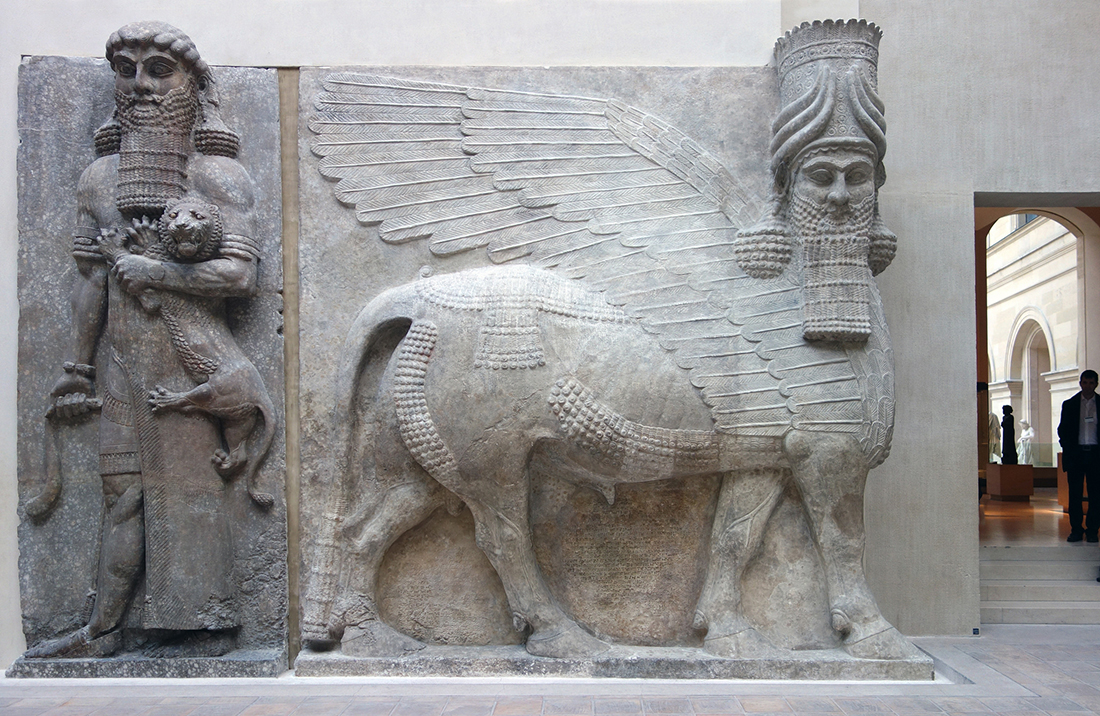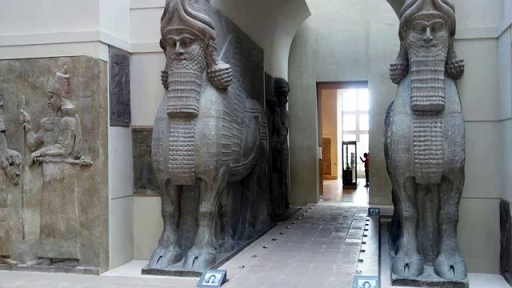These towering creatures were over four meters tall and depicted a beast with the body of a bull or lion the head of a man and the wings of an eagle. The cultural landscape online textbook.

Human Headed Winged Lion Lamassu Assyrian Neo Assyrian The Metropolitan Museum Of Art
A Sargons palace b Gudeas Lagash c Ashurbanipals palace d Ziggurat at Ur Which of the following played an important role in the shaping of modern art.
. What were the most common themes in Assyrian art. 720-705 BCE gypseous alabaster 420 x 436 x 097 m excavated by P-E. Lamassu were powerfully evocative of strength speed and intelligence.
The Sumerians placed small sculptures representing men and women in their religious shrinesThese sculptures were known as _____. What ethnic group is credited with the first system of writing known to man. Displayed originally where.
Made from cast stone with an ivory-colored finish statue measures 10 inches high 825 inches long and 275 inches deep. The Lamassu sculptures were recovered from where. Lamassu were placed on either side of the doorways of Assyrian palaces and of gateways to cities to protect against evil spirits and impress the neighbors.
Assyrian sculpture typically placed prominent pairs of lamassu at entrances in palaces facing the street and also internal courtyards. Musee du Louvre Paris France Image_Filename. Who made the lamassu.
They were double-aspect figures on corners in high relief. In 2015 a chilling video circulated online showed people associated with ISIS destroying ancient artifacts in both the museum in Mosul Iraq and at the nearby ancient archaeological site of. Where were the Lamassu sculptures originally displayed.
Sculpture is the branch of the visual arts that operates in three dimensionsIt is one of the plastic artsDurable sculptural processes originally used carving the removal of material and modelling the addition of material as clay in stone metal ceramics wood and other materials but since Modernism there has been an almost complete freedom of materials and process. Strengthening these bonds further were the so-called Panhellenic sanctuaries and festivals that embraced all Greeks and encouraged interaction competition and exchange for example the Olympics which were held at the Panhellenic. From the ninth to the seventh century BC the kings of Assyria ruled over a vast Written By whitehouse March 07 2022 Add Comment Edit.
The Lamassu seen from the side from the palace Sargon II r. Beth Harris and Dr. In the Assyrian mythology there were human headed winged bullslions that were protective genies.
Landscape online textbook the. Lamassu were supernatural spirits sometimes called demons or genies depending on which language youre translating from who served to protect the gods as well as the important human structures. Botta 1843-44 Musée du Louvre Speakers.
These massive sculptures served as symbolic guards of Assyrian kings domain being placed at the entrance to both the city and palace gateways See Collins 2008 72. Assyrian sculpture typically placed prominent pairs of lamassu at entrances in palaces facing the street and also internal courtyards. Lamassu was a characteristic of this late phase in the development of Assyrian art when sculpture was otherwise rare.
The original is located at the. Irreplaceable Lamassu sculpture Assyrian architecture and. The Lamassu served as the symbolic protector of a kings palace and where prominent in Assyrian architecture in the 800s and 700s BCE.
It was used at palace entrances and placed strategically by magicians to protect from evil. For this reason it is not an entirely freestanding sculpture. However many ancient Assyrian cities and palacesand their gates with intact lamassu figures and other sculpturesremain as important archaeological sites in their original locations in Iraq.
Architectural elements gates Medium. The Ziggurat at Ur was a fortress funerary monument palace temple platform Where were the Lamassu sculptures originally displayed. Originally unearthed in Rome and displayed in the Borghese Gallery it was sold to the occupying French and now sits in the Louvre.
From the front they appear to stand and from the side walk and in. Lamassu winged human-headed bulls possibly lamassu or shedu from the citadel of Sargon II Dur Sharrukin now Khorsabad Iraq Neo-Assyrian c. A lamassu B pictographs C votive figures D steles Erelief sculptures.
Where were the lamassu sculptures originally displayed. As said the Lamassu motif first appeared in imperial palaces in Nimrud throughout the reign of Ashurnasirpal II and vanished following the reign of Ashurbanipal who. It was considered by the Assyrians as a protective guardian of their houses palaces gateways and cities.
However it is displayed in a museum in its original context a lamassu is the guardian of a doorway integral with a wall. The first distinct lamassu motif appeared in Assyria during the reign of Tiglath-Pileser II as a symbol of power. Though the original is now on display at the Metropolitan Museum of Art this magnificent creature can stand watch over your living room study or office.
Lamassu winged bull-man gateway from the Palace of Sargon II at Khorsabad Dur-Sharrukin View. Steven Zucker IN THE NEWS. Lamassu from the citadel of Sargon II.
They were represented as double-aspect figures on corners in. Which work has a king approaching the god. The first change was the capital was moved to Dur Sharrukin present day Khorsabad and second the Lamassu was presented on a bulls body compared to a lions and seems to be slightly smiling.
It was discovered at the site of ancient Khorsabad around 1930 and dates to the reign of Sargon II 721-705 BC. Reproduction statue of a guardian lamassu. Furthermore where were the lamassu sculptures originally displayed.
Assyrian Human Headed Winged Bull Miniature Replica This miniature replica is a giant Winged Lamassu of Assyria from the Palace of Sargon II. 721-705 BCE Part of a collection at the Louvre in Paris France.

Lamassu Symbol For Protection Indrosphere

25 Lamassu From The Citadel Of Sargon Ii Dur Sharrukin Modern Iraq Ap Art History

Lamassus At The Louvre Thatmuse
Human Headed Winged Bull Lamassu Assyrian Neo Assyrian The Metropolitan Museum Of Art

Lamassu Backstory Article Assyrian Khan Academy

Lamassu From The Citadel Of Sargon Ii Video Khan Academy
Colossal Lamassu Sculpture From The Palace Of Sargon Ii At Khorsabad Sargon Ii Google Arts Culture

0 comments
Post a Comment